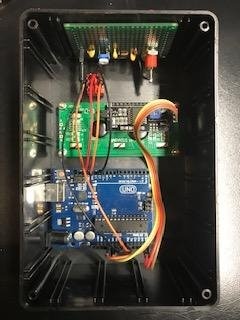Today, I shift my focus to RF. As part of the November 2019 Radio Frequency challenge, I plan to test antenna radiation patterns. But I'm also cheap. So... I plan to do this with simple radio frequency detector circuits. Why not?
There are many variations of the RF detector circuit. I chose the one below.
I've build three iteration of this circuit. The first is in a Harbor Freight free with purchase multimeter. This build seems the most consistent. The second build has a BNC connector and I tried a stock antenna (rubber duck). I then built this one with the same banana plug setup as the Harbor Freight meter. The only difference between version 2 and version 3 was version 2 was more selective of frequency and version 3 responds to... everything (fluorescent lights, CFL bulbs, etc.).
I drilled the hole for the banana plug jack. I placed the parts and started soldering. THANK YOU to everyone who has posted a video of soldering up proto board. I always tried to complicate it. Not any more.
Now it was time to give it some output. Arduino with LCD. I should also throw in a reset button since I want to display a running peak value. Put it in a (que dramatic music)... project box.
Yes, they still make those. The schematic colors don't match what I used.
The only thing I forgot to add was the warning LED that the sensed voltage was approaching the 5V limit. The warning and 2 second pause (to notice the light) are still in the sketch. I'll add it later - when I find the hot glue gun.
I probably over-documented the Arduino sketch - but I'll thank myself later when I ask myself what I was thinking when I wrote it.
Time for a test run. 5w to 8w on the radio. I started with the radio about 2 meters away. There is no scaling of the 0 to 1023 value - since it isn't important for my antenna radiation pattern testing.
Yes. Yes. Licenced amateur. Yes. Used call and announced what I was doing. Yes. Checked frequency before use. No. It didn't make any difference if I was speaking into the microphone or not.
CONCLUSION: This is a very simple circuit. Unfortunately, it is inconsistent and will require multiple tests to insure somewhat congruent results. The inconsistency makes it impossible to make multiple detectors give similar readings. I'm going to try anyway. One more project for Makevember!









Top Comments
-

shabaz
-
Cancel
-
Vote Up
+5
Vote Down
-
-
Sign in to reply
-
More
-
Cancel
-

three-phase
in reply to shabaz
-
Cancel
-
Vote Up
+4
Vote Down
-
-
Sign in to reply
-
More
-
Cancel
-

shabaz
in reply to three-phase
-
Cancel
-
Vote Up
+2
Vote Down
-
-
Sign in to reply
-
More
-
Cancel
Comment-

shabaz
in reply to three-phase
-
Cancel
-
Vote Up
+2
Vote Down
-
-
Sign in to reply
-
More
-
Cancel
Children